The base of the Cambrian is traditionally thought of as the point at which large, mineralised body fossils first appear in the geological record, giving us a much-improved record of the development of life up to the present day. However, the latest Neoproterozoic was not purely the domain of bacteria and algae – some rather more interesting and enigmatic fossils are patchily preserved. Namibia is a good place to find these Ediacara (sometimes referred to as the ‘Vendian fauna’). I came across a surprising number of them, given that I’ve come up empty in some of the most fossil-rich localities in the British Isles.
The highlight was probably this critter, Pteridinium:
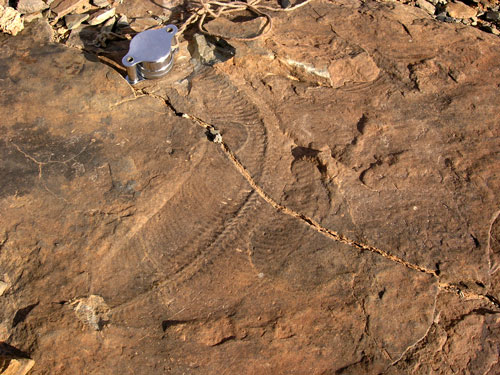
This is not a body fossil – nothing remains of the original animal, just the impression it left on the sediment. The level of detail is surprising given that it is found in relatively coarse-grained sandstone; it is thought that encrusting algal mats helped to stabilise the sediment surface and allowed the mould to survive burial. This ‘death-mask’ preservation is fairly unique to fossils of this age, because it is inhibited by algal grazing and bioturbation, both much more common after the beginning of the Cambrian.
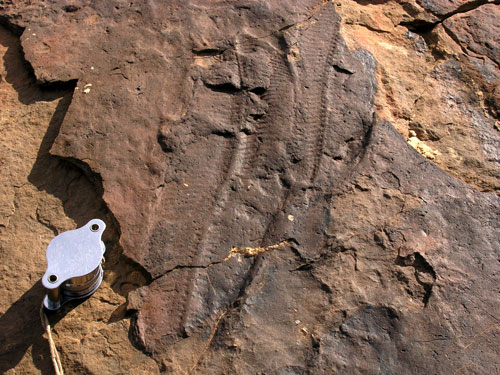
Pteridinium is pretty representative of the general oddness of the larger Ediacaran fossils, in that it’s generally difficult to work out exactly what they were, and their relationship – if any – to the post-Cambrian fauna (there’s a nice discussion here – scroll down to ‘Affinities’). You might think that it looks a bit worm-like, but that’s a trick of preservation; more three-dimensional specimens show that this thing had three lobes rather than two, and doesn’t have an internal body cavity. Their close association in the second photo suggests that they might have been sessile, or fixed on the sediment surface, as in the reconstruction, featuring other Ediacaran organisms, below (1=Pteridinium, 2=Dickinsonia, 3=Charnia, 4.=Rangea).
The other two fossils we saw were much smaller, but just as interesting because they are actual body fossils. Here’s Namacalathus (in the top left):

and here’s a couple of photos of Cloudina -(the swirly looking things you see if you follow the axis of the hand lens):
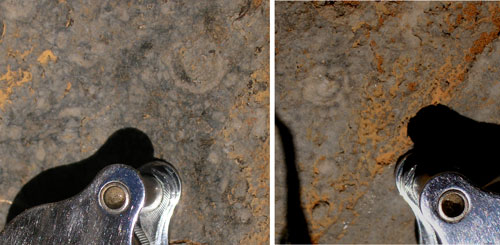
Both of the pictures show cross-sections; it is only by looking at lots of these fossils, which have been cut through in different planes, that you can build-up a true 3D picture of what they looked like. Namacalathus appears to consist of a cup-like chamber on a stalk. The cup has several openings in its side, which you can see on the bottom left of the one in my photo. Cloudina consists of a series of nested calcium carbonate tubes, which it is thought might be the result of upward growth to avoid being buried by accumulating sediment.
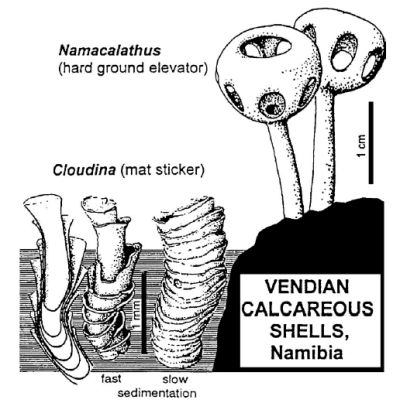
Diagram is Fig. 39 of McCall (2006)
They might look quite unimpressive (especially in my photos), but as part of the ‘small shelly fauna’ which started appearing in the very latest Neoproterozoic (Precambrian), these two organisms are amongst the first to start producing a calcium carbonate skeleton. This is a key, possibly the key, biological change which occurred across the Cambrian boundary – it is hard to imagine a diverse ecosystem where nothing could make skeletons, shells, or teeth.
So, how jealous do you think PZ is going to be now?

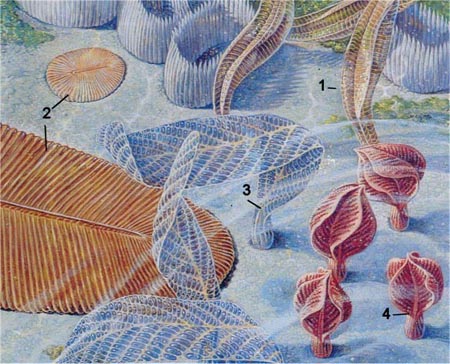


Comments (6)
Links (1)-
Pingback: Neoproterozoic signs of life |